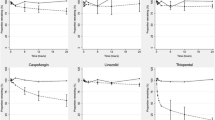Abstract
Objective
Although water-soluble drugs can be removed by haemofiltration/haemodialysis, morbidity and mortality from intoxication with protein-bound drugs remains high. The present study investigates whether albumin dialysis in the form of the Molecular Adsorbents Recirculating System (MARS) is effective in removal of protein-bound drugs.
Design
Prospective animal study.
Setting
Surgical research laboratory in a university hospital.
Subjects
Seven female Norwegian Landrace pigs.
Intervention
We studied whether midazolam (97% albumin-bound) and fentanyl (85% alpha-1-acid glycoprotein-bound), administered as anaesthetics to pigs with induced acute liver failure, could be removed by MARS dialysis lasting for 4 h.
Measurements
After 4 h of dialysis, total and free anaesthetic concentrations were measured in the blood and dialysate from different segments of the MARS circuit.
Main results
Midazolam: total plasma concentrations fell by 47.1±2.1% (in 4 h) across the MARS filter (p<0.01). The charcoal component of the system reduced the total dialysate drug concentration by 16.4±2.2% (p<0.05). Free midazolam removal followed a similar pattern. Fentanyl: total plasma concentrations fell by 56.1±2.4% (in 4 h) across the MARS filter (p<0.01). Clearance of fentanyl from the dialysate by the charcoal was 70±0.7% at 4 h (p<0.001).
Conclusions
The results of the study show that MARS can remove both albumin and other protein-bound drugs efficiently from the plasma, and it may have a place for the treatment of patients suffering from intoxication with this class of compounds.


Similar content being viewed by others
References
Stange J, Ramlow W, Mitzner S, Schmidt R, Klinkmann H (1993) Dialysis against a recycled albumin solution enables the removal of albumin-bound toxins. Artif Organs 17:809–813
Stange J, Mitzner S, Ramlow W, Gliesche T, Hickstein H, Schmidt R (1993) A new procedure for the removal of protein bound drugs and toxins. Asaio J 39:M621–625
Stange J, Mitzner S (1996) A carrier-mediated transport of toxins in a hybrid membrane. Safety barrier between a patients blood and a bioartificial liver. Int J Artif Organs 19:677–691
Sen S, Ratnaraj N, Davies NA, Mookerjee RP, Cooper CE, Patsalos PN, Williams R, Jalan R (2003) Treatment of phenytoin toxicity by the Molecular Adsorbents Recirculating System (MARS). Epilepsia 44:265–267
Physicians’ Desk Reference (2002) 56th edn. Medical Economics, Montvale, N.J.
Ytrebo LM, Nedredal GI, Korvald C, Holm Nielsen OJ, Ingebrigtsen T, Romner B, Aarbakke J, Revhaug A (2001) Renal elimination of protein S-100 beta in pigs with acute encephalopathy. Scand J Clin Lab Invest 61:217–225
Ytrebo LM, Nedredal GI, Langbakk B, Revhaug A (2002) An experimental large animal model for the assessment of bioartificial liver support systems in fulminant hepatic failure. Scand J Gastroenterol 37:1077–1088
Lapatto-Reiniluoto O, Kivisto KT, Neuvonen PJ (1999) Effect of activated charcoal alone or given after gastric lavage in reducing the absorption of diazepam, ibuprofen and citalopram. Br J Clin Pharmacol 48:148–153
el-Sayed YM, Hasan MM (1990) Enhancement of morphine clearance following intravenous administration by oral activated charcoal in rabbits. J Pharm Pharmacol 42:538–541
Torrente A de, Rumack BH, Blair DT, Anderson RJ (1979) Fixed-bed uncoated charcoal hemoperfusion in the treatment of intoxications: animal and patient studies. Nephron 24:71–77
Koffler A, Bernstein M, LaSette A, Massry SG (1978) Fixed-bed charcoal hemoperfusion. Treatment of drug overdose. Arch Intern Med 138:1691–1694
Wiesner G, Taeger K, Peter K (1996) Serum protein binding of fentanyl. The effect of postoperative acute phase reaction with elevated alpha 1-acid glycoprotein and methodologic problems in determination by equilibrium dialysis. Anaesthesist 45:323–329
Lehmann KA, Schmitz KF, Daub D (1983) Disposition of fentanyl in human blood. Anaesthesist 32:329–334
Litovitz TL, Klein-Schwartz W, Rodgers GC Jr, Cobaugh DJ, Youniss J, Omslaer JC, May ME, Woolf AD, Benson BE (2002) 2001 Annual report of the American Association of Poison Control Centers Toxic Exposure Surveillance System. Am J Emerg Med 20:391–452
Acknowledgements
This work was supported by the Liver Research Foundation, the Norwegian Research Council and the Sir Siegmund Warburg Voluntary Settlement. Teraklin AG provided the MARS kits free of cost.
Author information
Authors and Affiliations
Corresponding author
Rights and permissions
About this article
Cite this article
Sen, S., Ytrebø, L.M., Rose, C. et al. Albumin dialysis: a new therapeutic strategy for intoxication from protein-bound drugs. Intensive Care Med 30, 496–501 (2004). https://doi.org/10.1007/s00134-003-2141-0
Received:
Accepted:
Published:
Issue Date:
DOI: https://doi.org/10.1007/s00134-003-2141-0




